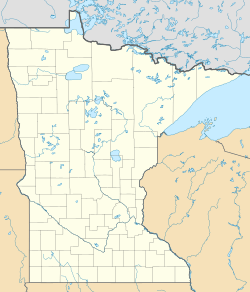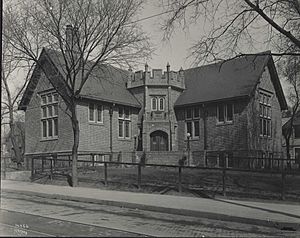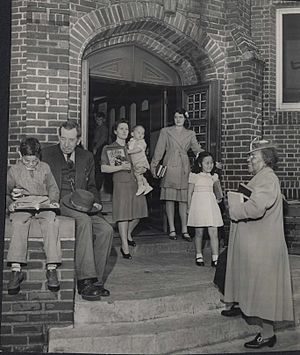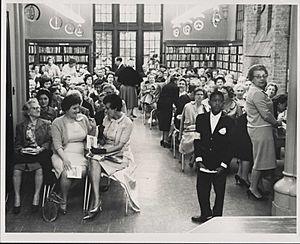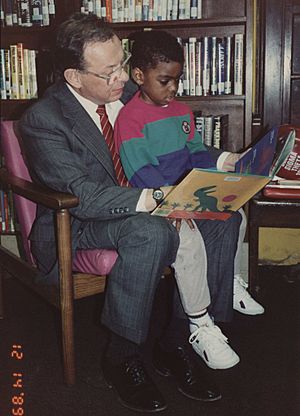Sumner Library facts for kids
Quick facts for kids |
|
|
Sumner Branch Library
|
|
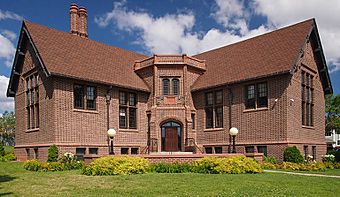
Sumner Library from the southeast
|
|
| Location | 611 Van White Memorial Boulevard, Minneapolis, Minnesota |
|---|---|
| Built | 1915 |
| Architect | Cecil Bayless Chapman, Haglin, & Stahr |
| Architectural style | Tudor Revival |
| NRHP reference No. | 00000539 |
| Added to NRHP | May 26, 2000 |
The Sumner Library is a neighborhood library in the Near-north area of Minneapolis, Minnesota. It was first part of the Minneapolis Public Library. In 2008, it joined the larger Hennepin County Library system.
This library is a special type called a Carnegie library. These libraries were built with money from a rich businessman named Andrew Carnegie. Sumner Library was a very important place for Jewish immigrants in the early 1900s. They could learn English here and join social groups. The library even moved all its Yiddish and Hebrew books to this branch because so many Jewish immigrants used it.
The building itself is designed in a style called Tudor Revival. It is so important that it is listed on the National Register of Historic Places. This means it's a historic site worth protecting. In 2015, the library celebrated its 100th birthday!
Contents
How Sumner Library Started
Sumner Library first opened on June 5, 1912. It was in a small, rented store room. Many young people came to read books. Adults also used books for kids to help them learn English. About 90% of the people using the library back then were Jewish immigrants. They especially wanted books in Russian, Yiddish, and Hebrew. These foreign language books were so popular they were "read out" (meaning all checked out) by 1913.
Just before the library opened, the Minneapolis Public Library got exciting news. The Carnegie Corporation offered them $125,000 to build four new branch libraries. Gratia Countryman, who was the Head Librarian, worked very hard to get this money. She believed that having more branch libraries would help the library reach as many people as possible.
Sumner Library was the third of these four new libraries built with Carnegie's money. A local architect named Cecil Bayless Chapman designed the building. It was built in the Tudor Revival style, which looks a bit like old English houses. The library had brick walls, arched ceilings, and a central tower. The new Sumner Library officially opened on December 16, 1915. It was located at 6th Ave. N and Emerson. Even after just one month, the new building was already too small! Staff said that many children couldn't find a place to sit, and adults often had no room at all.
A Library for Everyone
Sumner Library has always been a key place for helping immigrants settle into life in the United States. Soon after it opened, the library offered classes to help people learn English and become citizens. Many adults in the neighborhood did not speak English. So, library staff would ask children, who often knew English, to tell their parents about the classes.
Today, the library still helps people learn. It offers tutoring and classes through the Open Door Learning Center. These programs help people earn their GED (a high school equivalency diploma), learn English, and study for their citizenship test.
Serving Different Communities
Sumner Library has welcomed many different groups of people. When it first opened, most people using the library were Jewish. Adelaide Rood, who was the Branch Librarian for many years (1916-1953), saw the library as a place where different cultures could understand each other. In 1931, the library held its first "Jewish Book Week." They showed Jewish books and other items. In the 1940s, the library decorated for both Christmas and Hanukkah. This helped create a friendly feeling among all the people who visited.
However, by the 1920s, many Jewish families started moving to other parts of the city. By 1961, the library noted that the neighborhood was mostly African American. Because of this, the library's collection of Yiddish and Hebrew books was moved to the main Central Library.
African Americans have lived near Sumner Library since before it was built. In the 1920s, the library set up reading rooms in a church and a community center. This helped them reach more African Americans in the Northside area. In the 1970s, Branch Librarian Grace Belton worked to collect books and resources on Black history and literature. This helped preserve Black heritage and make these resources available. By 1988, this special collection had 2,500 books. In 1998, it was named the Gary N. Sudduth African American History and Culture Collection. This was to honor Gary N. Sudduth, a Library Board Trustee and president of the Urban League. As of 2015, the collection has over 5,000 books for kids, teens, and adults.
From the 1920s to the 1940s, Sumner Library also served Finnish people. It had a collection of Finnish books until 1954, when they were moved to the Central Library.
In the 1980s, people from Southeast Asia began living near and using Sumner Library. By the 1990s, people from Somalia and Ethiopia also moved to the Northside and started using the library. As of 2015, the library has special collections of books in Somali, Hmong, and Spanish languages.
Changes to the Building
After Sumner Library opened in 1915, it was often too small. In 1927, a much-needed addition was built on the west side of the library. This new part held the children's room and a workroom.
In 1938, something amazing happened: Sumner Library was moved! The entire building was shifted 100 feet north. This was done to make room for widening 6th Avenue. A team of six men moved the building very slowly, just one-eighth of an inch at a time, using a large jack. Books inside were covered with newspaper to keep them safe. Moving the library cost $32,000. At the same time, a new section was added to the north side of the library. This new part was used as an office and a reference room.
In 2004, the library was updated again. New sections were built on the north and west sides. The main entrance was also moved to the north side of the building. Older parts of the library were also fixed up and kept safe. This helped keep the building's original design. Minneapolis architects Mohammed Lawal and Peter Sussman designed these changes. Mohammed Lawal grew up in the Northside area and used Sumner Library when he was a child.
Fun Programs and Activities
Sumner Library has become an important community space. It has hosted many clubs, events, and classes over the years. Programs for children were especially popular when the library first started.
Clubs for Kids and Teens
From the 1920s to the 1940s, Boy Scout troops often met at Sumner Library. In 1927, the staff started a library club just for girls. Members of this club would fix books and magazines, put books back on shelves, and help keep the children's room tidy. This club was so popular that there was a waiting list to join! In 1947, the library offered a book club for teen girls. During the 1950s, movies for adults were shown regularly. In the 1960s, the library showed movies based on children's books.
Helping People Learn to Read
In 1980, Branch Librarian Grace Belton noticed that many adults near Sumner Library needed help with reading. So, a literacy class for adults started the next year. This class was very successful and many people wanted to join. However, the program had to stop soon after it started because of money cuts.
Soon after, the Minnesota Literacy Council started an adult reading program at Sumner Library. This program became known as the "Northside Reading Center." Today, it is called the Open Door Learning Center. Grace Belton also worked hard to create reading programs for children. She hosted storytimes, visited schools, met with parents, and developed some of the library's best summer reading programs for kids. When Dan Kelty became the Community Librarian in 1999, the summer reading program became very popular. About 2,000 children joined the library's Reading Club!
Today, programs at Sumner Library still focus on helping people learn. This includes reading, writing, homework help, conversations, and art. The library has regular programs for adults, like homework help and conversation groups for people practicing English. Regular programs for children include homework help, baby storytime, family storytime, and childcare group storytime. Special events like "Sing Play Learn," the Juneteenth Celebration, and genealogy research are also held. The Friends of Sumner Library group also helps support these programs.
Famous Visitors
Sumner Library has welcomed many famous people over the years. In 1962, Harrison Salisbury, a well-known author and newspaper columnist, visited. He had been a patron of Sumner Library when he was young. He spoke at the library's 50th anniversary party.
In 1981, the famous poet Maya Angelou visited and gave a talk at Sumner Library. Justice Alan Page and his wife Diane visited the library in 1984. They were part of a program called "Read…By All Means," which encouraged people to read. In 2013, James Meredith, a leader from the American Civil Rights Movement, also visited the library.


